-
Posts
388 -
Joined
-
Last visited
Content Type
Profiles
Forums
Blogs
Gallery
Events
Store
Posts posted by Eduardo
-
-
Here I show a postcard of the interior of the St. Sauveur church in Verdun, The card was printed in Paris and numberes 3707. It is signed in the front by "La Pense".
Eduardo
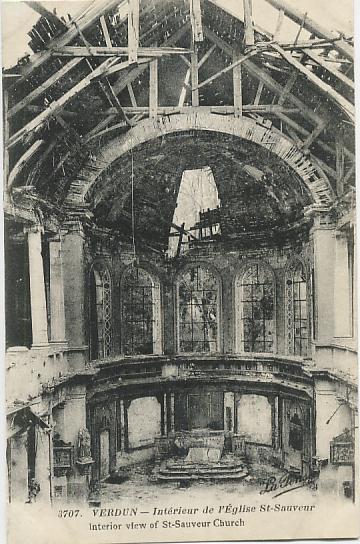
 0
0 -
This postcard which I have clasified as "Nr. 202" for obvious reasons, shows a partial view of a town with some badly destroyed houses while others seem intact. It was whitten on six February 1918 and posted the following day. Now knowing German I can only read the entering line, "My dear ones". Maybe the seals in the back or the visual memory of a forum member could help to know which town it is. The Editor references are also in the back including the street number but again, I can't read that script.
Eduardo
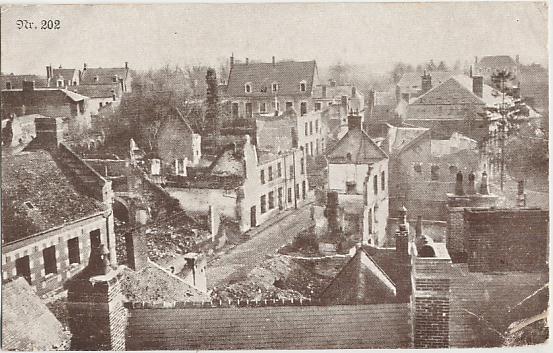
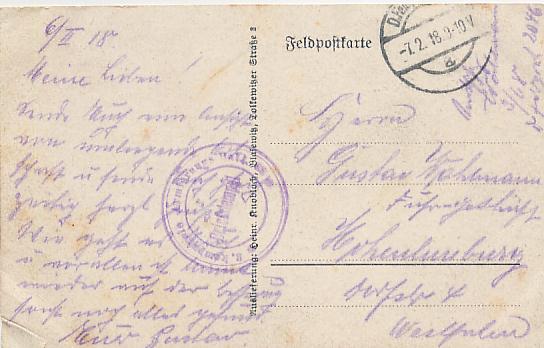

 0
0 -
Thanks Hendrik for the translation on the St Baussant card, and Kevin in Deva for the interesting explanation on the Zeppelins. I have always liked them but just realize have never read much about these machines.
Eduardo
0 -
This card has no reference to the place it depicts in the front. As for the printer there is very light blue triangle with a sun in the center. And there is also what I understand to be the geographical reference, also in very light blue but which I have been able to scan with a contrast light. I guess it is from St. Baussant but have no idea of the rest of the inscription.
Eduardo
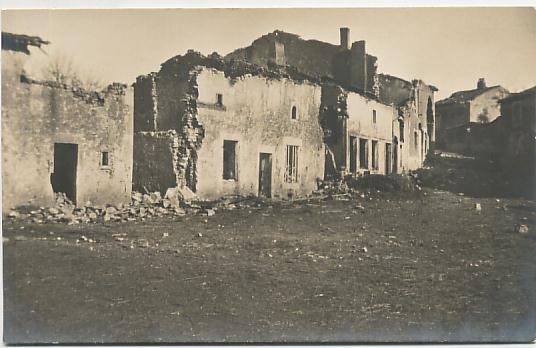


 0
0 -
Thank you Hendrik, I will add that information to my file. I tought that the planes were escorting the "Hansa", not attaking her. Just to clear the point. How could they protect themselves from attacks comming from above?
Eduardo
0 -
I am interested in photographs of the Great War, not in drawing, cartoons and alike. I have presented some of the former but they have arrived as gift and must say that even when I find them also fascinating I don?t want to open a new front to my already too many fields of interest. The card presented here, non the less, was purhased directly by me because I love it as soon as I saw it. It is signed by "Hans Rudolf Schulze". I cannot read German so I know I am loosing part of the fun by not understanding the two blocks in the back. I am including them here for the preasure of those who might want to read them.
Eduardo
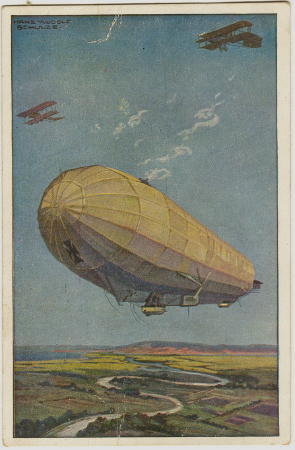

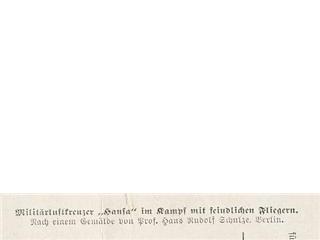


 0
0 -
This card if from BREMENIL and dated 1915. It was printed by N? 3 Walter TechNeugersdorf i. Sa. and has two seals stamped. One, blue ink "Koninglich Preussische Festu_gs-Masch. Gewehr - Komp. Nr. 9" and the other one in black ink "Fels...si Expedition 2.7.15. 1-2N XIX. Wersatz Division.
Eduardo
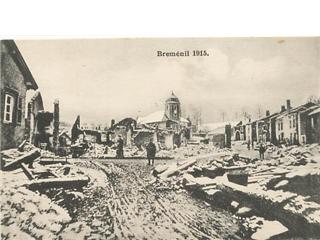
 0
0 -
Thanks Hendrik,
I will read all the links you send me. It is always good to hear from you. Will be back with comments.
Eduardo
0 -
Thank you again Hardy. I am preparing a Power Point with the post card, the photographs and will enclose information of each one of the three.
Eduardo
0 -
As a Peruvian-Belgian and a historian, I was very surprised to find the book "Terrorismo aleman en B?lgica" by Arnold Toynbee in a ussed book stand in the street in Lima. Some of the things told about the entrance of the Germans in Liege had been told to me by my grandparents when I was a young boy so the book captured me from the first page.
I have never seen the English version but supose there is one. There is no reference to it in the book I have, though. The introduction was made by "Ramiro de Maetzu" of whom have never read anything besides these few pages. The book has 20 photograph (printed) and three maps (only two in my copy). I have scan all the photographs and one map- If there is any interest I would gladly post them here.
Eduardo
PS. Have posted a pic of the book: "Liege under German power"

 0
0 -
Yes Hardy, your deductions are sound logical. Wonder if the cross with the 1914 on it says something else. I can read the artist name Georg ....., but still don't get the translation of the motto in the card. Will ask a German friend. I find the card very colorfull and pretty.
Thank you.
Eduardo
0 -
Hello. In the collections section I have posted a postcard where the Imperial guard is parading in front of the Kaiser. The text of the card explains that these same troops, pride of Germany, were anihilated by the French "Turcos" at the battle of Charlerois.
I have not found references to the Battle of Charleroi. Could somebody give me references where to find details and know what hapened?
Eduardo
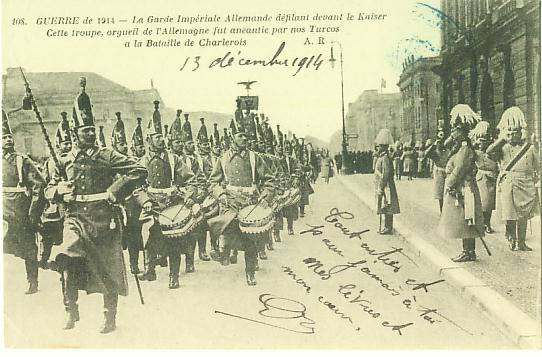
 0
0 -
Thank you Glenn for completing the trio. Thanks Mike and Naxos for your help with the other two. You are all a great group. As soon as I get the card I will post the back of it to see if there is something more to it. Still will like to know why the 3 together and the flags.
Eduardo
0 -
Could someone please translate the inscription under the photographs? There is also another smaller inscription that could be the artist signature. Also would like to know if there is a special reason for the flags, specially the Turkish flag. Since the three seem Austrian or German why would there be a reference to Turkey. Is the other flag Hungarian? I am not too clear with the colors.
Eduardo
0 -
Thanks to all. Two out of three are out of doubt. I will get the card and maybe we can find more if I make a larger scan or, who knows, maybe there is some writting in the back.
Eduardo
0 -
I have been ofered this postcard for my WWI postcard collection as Austrian. The card is colorfull and seems that the three persons portraited in it must be important. Could somebody tell me who they are? The flags are nor German nor Austrian. The ones in the right are Turkish.
Eduardo
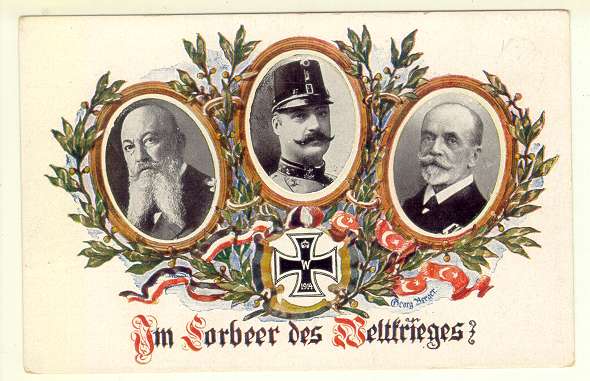
 0
0 -
This second pic of today, a static baloon, has the leyend: "One of the Army's eyes" and belongs to "The Daily Mirror Canadian Official Series". The card was printed in London by the "Pictorial Newspaper C?".
Eduardo

 0
0 -
This card and the following one have arrived today from France. This first one shows a parade of the Imperial Guard in front of the Kaiser. The french terxt explains that same troop, pride of Germany, was anihilated by the French "Turcos" at the battle of Charlerois. The card in hand dated in both sides and was issued by A. Richard. 84, Faubourg du Temple.

 0
0 -
Thanks. I am glad to be able to colaborate with something more tamn my postcards. Here I will list the name and tonage of the German ships that were "captured" by the Peruvian navy and rented to an American organization named "Emergency Fleet Corporation". (Note: in my texts two tonnage are given. "porte" the largest and "registro bruto". I can't find the English equivalent but anybody familiar with ships will understand I guess).
The steam ships: Porte Registro Bruto
Sierra Cordoba (name changed to "Callao") 8,200 8,220
Luxor (to "Salaverry") 12,000 7,109
Rhakotis (to "Eten") 8,500 6,982
Anubis (to "Paita") 8,000 4,763
Uarda (to "Pisco") 9,000 5,751
Marie 3,000 1,866
Sail Ships:
Hebe 4,000 2,469
Omega 4,000 2,471 *
Maipo 2,700 1,770
Tellus 2,500 1,465
The Uarda and Luxor were rented by the Emergency Fleet Corporation to the French Government.
To my knowledge the Omega was kept in Per? with another sailing ship to transport guano ( the bird's fertilizer) from the islands to Callao. The Omega was the last sail ship to continue in activity and using only sails. She finally broke to pieces in the early 50's. There is a book about her written by an American. I had something to do with the translation and publication into Spanish. Will look arround in my library and will give more details.
Eduardo
P.S. The names that were given to the steam ships are those of Peruvian ports. The last one in the List, correspondes to Pisco, the Port-city totaly destroyed by the earthquake of last week
0 -
Even before Per? took sides in the war, there were many peruvians fighting in both sides but mainly in the French Army. Some were the children of Europeans who decided to fight for their parents countries and some just because they had special liasons to them.
Among them was JOSE GARCIA-CALDERON, a young architect and writter, son of a former Peruvian president and brother to two of the most renoun intelectuals of the day. Jose had been educated in France since a young age and in 1914, as the war was declared, he joined as a volunteer in the French Foreign Legion. He begun in the trenches where he reached the degree of Second Lieutenant. Then he was promoted to observer in airplanes and baloons. In this possition he received the War Cross with three palms.
Jose Garcia-Calderon died when his observation baloon was destroyed by the enemy in Verdun on 5th May, 1916.
Among his works there were some notes of his experience in the trenches which his brothers published partially later. Will try to find them and comment on them
Eduardo

 0
0 -
I thought I could place this thread in the "Research" section but guess it is to early. For some time now I have been thinking that it could be a good idea to mnake my history Ph.D. thesis in the participation of my country in the First World War. Nobody has really researched the subject. Of course, a marginal country in the other side of the world stiking its nose in the fight of the big ones is kind of wierd. But most countries in South America got involved. After all, Teddy Rooseveld had called un the "Backyard of the United States", and for many practical reasons we were.
The motive? A German submarine sunk our ship "Lorthon" in the Cantabric sea in front of Suances on 4th February 1917. The Lorthon carried nitrate "as fertilizer for the northern Spanish fields" and was going to deliver it at the port of Pasajes.
After several months, on 6 October 1917 the Peruvian Congress broke relations with Germany. Right after that 10 German ships that were in Peruvian ports were captured and given to an American company the "Emergency Fleet Corporation".
Another interesting aspect of Peruvian participation is the number of Peruvian born men who fought in both sides of the war.
If someone is interested in continuing this thread I will put more information. One of our pilots was Juan Bielovucic, the first man to fly over the Alps and survive. He fought for France.
Eduardo
0 -
I just got this card of King Albert I of Belgium in an airplane.
Eduardo

 0
0 -
Congratulations David F. You have very interesting CDV's and postcards. I collect only W.W.I postcards and a few are portraits or groups. I love them. Curiously all the portraits and groups (exept generals) are german. As you have noticed, the mesages in the back sometimes as interesting as the photograph.
Eduardo
0 -
Thanks Rick. It makes sence. The back is a long publicity to the bank loans indicating even the % out of taxes to be paid in the loans.
Eduardo
0




First World War postcards
in The Great War 1914 to 1918
Posted
A panoramic view of Verdun. If it was not for the broken tress in the front left, it could be difficult to know that the picture was taken during the war. This card, unused, was printed in Paris and nunbered 3675.
Eduardo